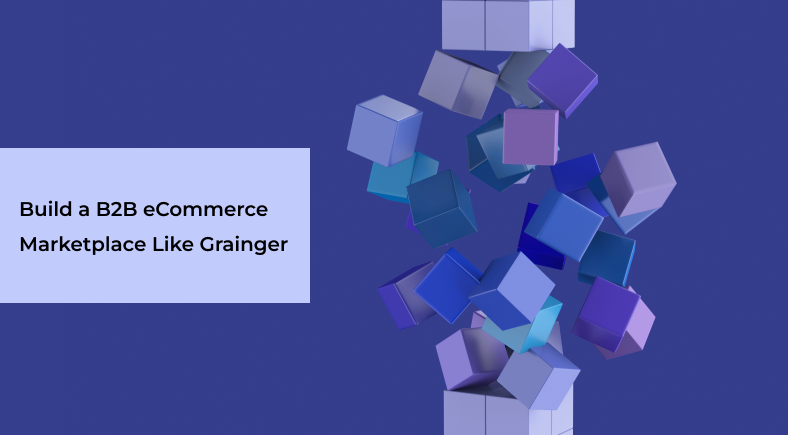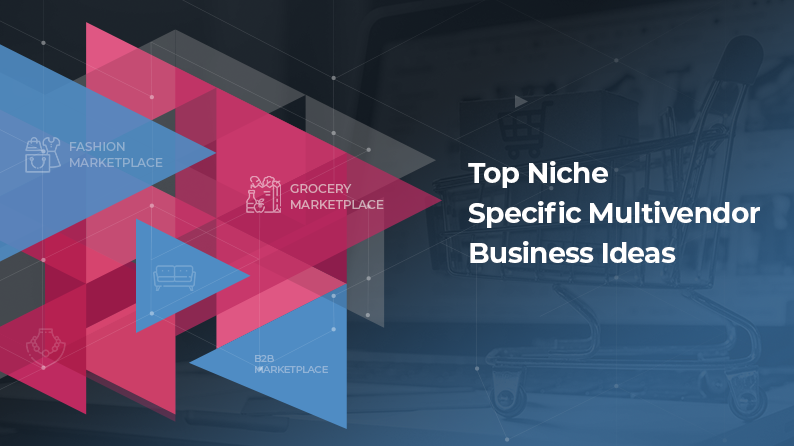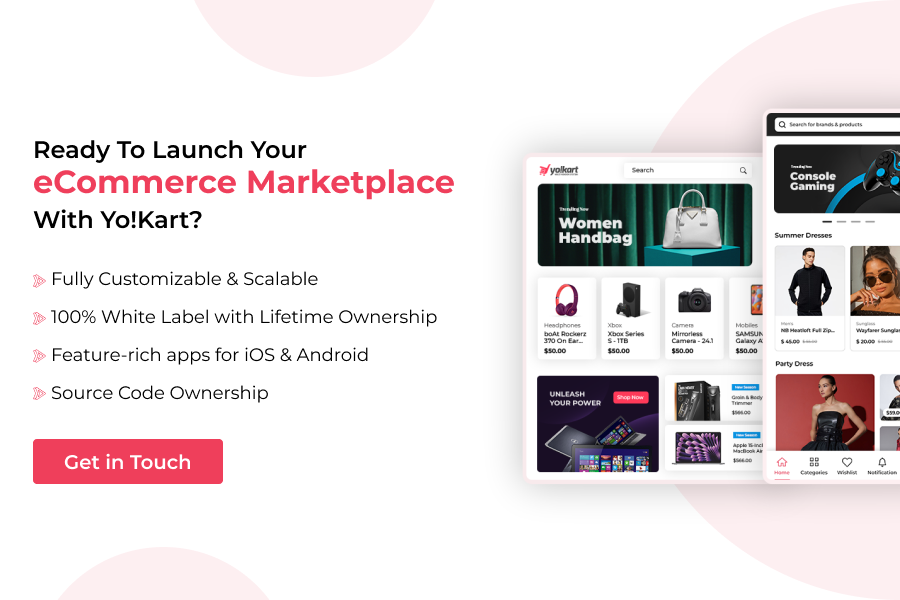In the digital-first era, the landscape of industrial supply and Maintenance, Repair, and Operations (MRO) is undergoing a massive transformation. The traditional models of distributors, catalogs, and sales calls are rapidly being replaced by sophisticated, scalable digital platforms. At the forefront of this evolution sits the B2B industrial eCommerce marketplace, a model that has proven its dominance through giants like Grainger.
Building a platform that can compete in this space is not just about creating an online store. It’s about architecting a robust ecosystem that caters to the nuanced needs of industrial buyers and suppliers and is integrated with advanced features such as AI-powered search, predictive inventory, and seamless ERP integration. Moreover, success in this market demands deep insight into buyer behavior, supplier management, and industrial procurement workflows.
Furthermore, this blog will provide you with the blueprint for developing a successful B2B industrial marketplace, exploring everything from understanding the core business model to selecting the right B2B marketplace software and executing a flawless development strategy.
Table of Contents
- What is a B2B Industrial eCommerce Marketplace?
- About Grainger: Its Business Model
- Top Marketplaces Like Grainger
- Must-Have Features in a B2B eCommerce Marketplace
- Steps to Build a B2B Industrial eCommerce Marketplace
- Yo!Kart: Best B2B Marketplace Software to Build a Marketplace Like Grainger
- Conclusion
What is a B2B Industrial eCommerce Marketplace?
A B2B (Business-to-Business) industrial eCommerce marketplace is a specialized online platform where multiple businesses (vendors) sell industrial goods, equipment, MRO supplies, components, and raw materials directly to other businesses (buyers). Unlike a single-vendor eCommerce site, the marketplace acts as an intermediary, facilitating transactions, managing logistics, and ensuring quality control across a vast catalog of diverse products.
The “industrial” aspect highlights the platform’s focus on goods used in production, manufacturing, construction, and operational maintenance, items that are often complex, require high-volume transactions, involve precise specifications, and demand rigorous compliance. Key characteristics of an industrial eCommerce marketplace include:
- Multi-Vendor Model: Hosts numerous independent sellers.
- Targeted Inventory: Focuses on MRO, PPE (Personal Protective Equipment), tools, electrical components, fasteners, hydraulics, and general plant upkeep.
- Complex Transactions: Handles features like bulk pricing, Request for Quotation (RFQ), contractual pricing, and integration with Enterprise Resource Planning (ERP) systems.
- High-Touch Service: Requires robust support for technical product specifications, compliance, and complex shipping logistics (e.g., hazardous materials).
This structure offers immense benefits, as buyers gain a single source for a vast range of products, consolidating procurement, and vendors access a broader market without the overhead of building their own high-traffic digital infrastructure.
About Grainger: Its Business Model
Any aspiring industrial marketplace must first study the undisputed heavyweight champion: W.W. Grainger, Inc.. Grainger’s business model is a masterclass in industrial distribution. Originally and primarily, Grainger operated as a single-vendor distributor, but now its current operation is a hybrid of a traditional distributor and an emerging marketplace.
Grainger purchases inventory from manufacturers, stores it in a massive network of distribution centers and branches, and then sells it directly to businesses. This model relies on:
- Massive Inventory & Reach: Maintaining a stock of millions of SKUs (Stock Keeping Units), ensuring product availability for immediate fulfillment.
- Logistical Excellence: Owning and controlling the end-to-end supply chain, ensuring fast, reliable delivery, often same-day or next-day.
- Customer Relationships: Providing expert technical support, sales, and account management to large institutional and industrial clients.
The Shift to a Marketplace Hybrid
In recent years, Grainger has moved toward a marketplace-like structure, particularly through its digital properties. While their core business remains distribution, they have started to strategically integrate third-party vendors and drop-ship programs to:
- Expand the “Long Tail”: Offer a wider selection of specialized or less frequently requested items that don’t warrant stocking in their own distribution centers.
- Increase Capital Efficiency: Reduce the need to hold inventory for every possible item, shifting that burden to the third-party seller.
- Maintain Dominance: Ensure that, regardless of the buyer’s need, Grainger’s site is the first and final destination.
The key takeaway from the Grainger model is the absolute prioritization of reliability, availability, and customer trust. Industrial buyers cannot afford downtime; they need the right part, right now, and Grainger delivers on that promise, whether the product is sourced directly or through a verified partner.
Top Marketplaces Like Grainger
The success of the Grainger model has inspired numerous competitors and innovators in the industrial B2B space, each with a slightly different focus or geographical strength.
| Marketplace Name | Primary Focus | Key Differentiator |
| Amazon Business | General B2B/MRO/Office | Global reachIntegration with consumer experienceVast product depth. |
| McMaster-Carr | Industrial, MRO, Tools | Unmatched product detailExcellent logisticsHighly reliable catalog. |
| Alibaba (1688/International) | Manufacturing/Raw Materials/Global Sourcing | Connects buyers directly with manufacturersFocus on bulk and custom sourcing. |
| Global Sources | Electronics, Components, Fashion | Focus on cross-border tradeConnects Asian suppliers with international buyers. |
| Zoro (Grainger Subsidiary) | MRO/Small Business | A digital-first, low-touch modelOffers competitive pricing on many Grainger items. |
| MSC Industrial Supply Co. | MRO and Metalworking | Strong focus on high-value itemsMetalworking toolsSupply chain solutions. |
The lesson from these competitors is that specialization matters. A new marketplace cannot simply mimic Grainger’s expanse. Hence, it must find a niche, perhaps focusing exclusively on sustainable industrial materials, heavy equipment parts, or a specific geographic region, and dominate that segment by providing unparalleled service and inventory depth.
Launch a Multi-Vendor B2B Marketplaces to Leverage this Proliferating Industry
Further, let’s explore some of the must-have features of a B2B eCommerce marketplace.
Must-Have Features in a B2B eCommerce Marketplace
Building a B2B ecommerce platform for industrial buyers requires a feature set far more robust than a standard consumer eCommerce site. The architecture must support complexity, scale, and compliance. Let’s have a look at some of the must-have features that you should incorporate in your B2B eCommerce marketplace:
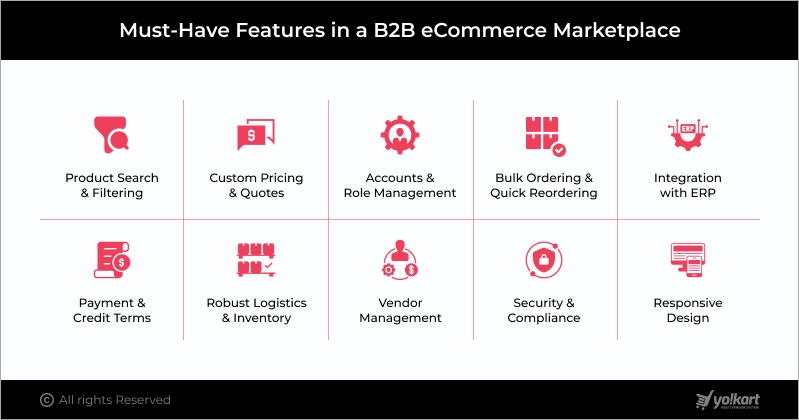
1. Advanced Product Search & Filtering
- Enables users to filter the products based on specifications such as size, material, brand, and compatibility standards.
- SKU-level search functionality allows precise sourcing of industrial components.
- Category-based navigation for an organized browsing experience across diverse product catalogs.
2. Custom Pricing and Quotes
- Offer dynamic tiered pricing based on volume, customer segment, or contractual agreements.
- Integrate a Request for Quote (RFQ) functionality for large, specialized, or complex orders.
- Allow in-platform negotiations, quote revisions, and contract management features for seamless transactions.
3. Multi-User Accounts and Role Management
- Support multiple users with different permissions and customizable roles.
- Enable approval workflows for purchase requests.
- Facilitate controlled access, ensuring that decision-makers authorize purchases while maintaining operational agility.
4. Bulk Ordering & Quick Reordering
- Allow easy upload of bulk order CSV files.
- Provide real-time order status updates, ensuring efficient procurement management.
- Offer quick repurchases based on previous purchases, saved favorites, or frequently ordered items.
5. Integration with ERP and Procurement Systems
- Provide robust API access for smooth synchronization of inventory, order processing, and invoicing.
- Support punch-out catalogs integrations for direct purchases through buyer procurement portals.
- Enable seamless communication between the marketplace and enterprise systems for end-to-end digital procurement.
6. Payment and Credit Terms
- Incorporate various payment options such as credit/debit cards, PO, internet banking, and more.
- Offer credit management tools to define limits, manage outstanding balances, and automate invoicing workflows.
- Facilitate transparent financial transactions with automatic tax and discount calculations.
7. Robust Logistics and Inventory Management
- Display real-time stock availability to prevent order delays and backlogs.
- Offer multiple shipping options with tracking.
- Include return, replacement, and warranty claim management to ensure buyer satisfaction.
8. Comprehensive Vendor Management
- Simplify supplier onboarding and verification through a digital guided process.
- Provide performance dashboards and analytics for vendors to monitor sales and service efficiency.
- Allow vendors to manage product listing, update prices, and track fulfillment performance easily.
9. Security and Compliance
- Implement role-based access controls to manage data visibility and operational permissions.
- Ensure data protection and secure payment standards with GDPR and PCI DSS compliance.
- Use encrypted data storage, SSL certificates, and secure payment gateways to safeguard transactions.
10. Mobile-Optimized and Responsive Design
- Deliver a mobile-friendly interface, ensuring accessibility and fast performance on all devices.
- Optimize page layouts and navigation for hassle-free browsing and ordering on smartphones and tablets.
- Enable mobile-requested quotes, one-click reorders, and real-time notifications for enhanced convenience.
A well-developed B2B industrial marketplace blends technological sophistication with buyer-centric functionality to drive operational efficiency and long-term engagement. By integrating the above features, businesses can create a robust ecosystem that streamlines procurement, strengthens supplier collaboration, and scales seamlessly with industry demands.
Build a Feature-rich Industrial eCommerce Marketplace
Next, let’s explore Steps to Build a B2B Industrial eCommerce Marketplace to turn this feature-rich concept into a market-ready digital platform.
Steps to Build a B2B Industrial eCommerce Marketplace
The construction of an industrial marketplace is a multi-faceted process requiring meticulous planning, strategic investment, and technological expertise. However, to make it simple for you, a step-by-step guide is provided below:
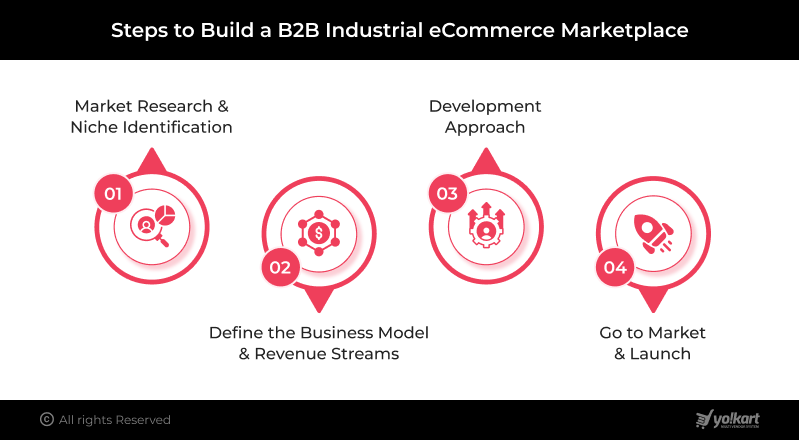
Step 1: Market Research and Niche Identification
The first mistake is trying to be “the next Grainger.” A new marketplace must target a specific, unserved market segment. Moreover, before entering the growing eCommerce landscape, thorough market research is crucial. The following are a few factors that you should cover while doing the market research.
- Identify the Niche: Will your industrial eCommerce marketplace focus on specialized metal components, regional construction supplies, or perhaps only sustainable MRO? It is suggested to focus on one specific niche as it will allow expert service, easier vendor acquisition, and more.
- Validate Demand: Conduct detailed analysis of Google search trends, competitive gaps, and direct surveys of potential B2B buyers in the chosen vertical.
- Feasibility Study: Determine the total addressable market (TAM) and the estimated cost of vendor acquisition, logistics, and technology.
Step 2: Define the Business Model and Revenue Streams
The choice of business model dictates the entire platform’s functionality and monetization strategy. Hence, below are some of the business models and revenue streams based on which your B2B industrial eCommerce marketplace can operate:
- Commission Model: The most common model, where the marketplace takes a percentage cut of every transaction. This should be tiered based on the product’s gross margin, complexity, or competitive landscape.
- Subscription/Listing Fees: Charging vendors a monthly fee to host their storefront, in addition to or instead of commission. This is useful for attracting high-volume, low-margin suppliers.
- Value-Added Services: Offering premium services such as Fulfillment by Marketplace (FBM), advertising/promotional slots, technical support, or data analytics to vendors for an additional fee.
Step 3: Development Approach
This is the make-or-break stage, deciding how the platform will be built. The options range from a custom build to using specialized B2B marketplace software.
A. Custom Development
Custom development means building your B2B marketplace entirely from scratch, tailored precisely to your business model, workflows, and integrations (e.g., a proprietary ERP or complex pricing engine). This route is often taken by enterprises with highly specific or innovative requirements that cannot be met by existing platforms.
Pros:
- Total flexibility to design the platform around your unique business processes.
- Absolute control over features, roadmap, security, and integrations.
- Perfect fit for highly specialized industries or use cases that off-the-shelf solutions cannot address.
Cons:
- Extremely high upfront cost due to the need for a full engineering team (UX/UI, backend, DevOps, QA).
- Very long development cycle, typically 18 to 36 months to build and stabilize a working product.
- High ongoing maintenance with a need to manage bug fixes, updates, server scaling, and infrastructure.
- Significant technical risk, including delays, underestimation of complexity, and team dependency.
- Delayed feedback loop from real users due to the long build time, which increases product-market misfit risk.
B. Ready-Made B2B Marketplace Software
Ready-made marketplace software significantly reduces the time and effort needed to launch a marketplace by providing built-in features like vendor management, multi-vendor checkout, and commission systems. These solutions come in two primary forms:
1. SaaS-Based (Software-as-a-Service)
These are cloud-hosted, subscription-based marketplace solutions managed entirely by the vendor (e.g., Mirakl, Arcadier, Sharetribe Flex, Marketplacer). Ideal for teams wanting a low-code or no-code solution.
Pros:
- Fastest time-to-market (often 3–6 months or less).
- Lower upfront investment, with predictable monthly or annual costs.
- Market-tested features like order routing, vendor onboarding, and commission logic.
Cons:
- Limited customization: You are bound by what the platform allows, often with few deep customization options.
- Vendor lock-in, makes it hard to migrate away if the platform no longer fits your needs.
- Limited control over performance and scalability makes you rely on their infrastructure entirely.
- Restricted access to code, meaning complex features such as B2B workflows, unique pricing rules, and more may be difficult or impossible to implement.
- Dependent on the vendor’s roadmap, which may not align with your growth or industry-specific needs.
2. Self-Hosted Ready-Made Solutions(e.g., Yo!Kart)
These are full-featured, self-hosted marketplace software solutions, which you can install and host on your own servers or cloud infrastructure. Designed for scalability and configurability, they combine the speed of a ready-made solution with the power of code-level access.
Pros:
- Comes with comprehensive B2B marketplace features such as multi-vendor, RFQ, commissions, role-based access, and much more.
- Full control over hosting and infrastructure, thus, you can scale and secure it your way.
- Code access for deeper customization, often included or available at an additional cost.
- Vendor independence: You control the code and platform without being locked into a hosted service.
- Faster launch than custom development, typically within 3–6 months with basic customization.
Con:
- Learning curve for entrepreneurs new to such systems, due to the extensive feature set and administrative complexity.
Suggest Read: List of Best White-Label B2B Marketplace Software
Step 4: Go to Market & Launch
After development, focus on launching with an MVP that includes only essential features like search, RFQ, tiered pricing, and basic vendor management. Moreover, securing a few high-quality vendors early on is crucial to ensure a strong product catalog, as quality matters more than quantity. Use targeted outreach via LinkedIn, trade groups, and email to attract both vendors and buyers. Further, start with simple logistics, preferably vendor-managed shipping, to reduce operational overhead.
Post-launch, it is important to closely track user behavior to identify friction points and collect feedback to make improvements. Gradually roll out advanced features like ERP integrations and vendor analytics. Additionally, ensure ongoing investment in security and compliance to support scalable, long-term growth while maintaining buyer and vendor trust.
Transform Your Industrial Business with a Tailored eCommerce Marketplace
Yo!Kart: Best B2B Marketplace Software to Build a Marketplace Like Grainger
Among the leading dedicated B2B marketplace software solutions, Yo!Kart stands out as a strong candidate for building an industrial marketplace. This white-label, self-hosted, multi-vendor eCommerce software is specifically designed to handle the complexities of industrial B2B marketplaces, similar to giants like Grainger..
Furthermore, with its seamless integration of multiple payment gateways and ERP systems, it ensures smooth inventory, order, and financial management. In addition to it, Yo!Kart offers comprehensive support, including source code ownership and ongoing technical assistance, ensuring long-term success and control for marketplace operators.
Additionally, built-in SEO, marketing capabilities, and mobile optimization empower businesses to create a professional, efficient, and user-friendly marketplace tailored to industrial buyers and suppliers.
Let us discuss some key reasons that make Yo!kart suitable for a Grainger-like venture:
1. Dedicated B2B Functionality: It includes crucial B2B features like separate B2B/B2C storefronts, bulk purchasing, tiered pricing, RFQ management, and multi-user corporate accounts built into the core system, not as an insubstantial third-party extension.
2. Scalability: The architecture is designed to handle a vast number of SKUs and high transaction volumes typical of industrial MRO.
3. Ownership and Customization: Unlike pure SaaS models, Yo!Kart is a one-time purchase with the source code provided, offering complete ownership and the freedom for developers to integrate proprietary systems without ongoing licensing limitations.
4. Vendor Management: It provides comprehensive, dedicated dashboards for vendors to manage their inventory, commissions, tax settings, and shipping profiles independently, easing the burden on the marketplace operator.
By using a platform like Yo!Kart, an entrepreneur, bypasses the two-to-three-year timeline and multi-million-dollar cost of a custom build, allowing them to rapidly establish a minimum viable product (MVP) and focus resources on acquiring reliable vendors and large corporate buyers.
Schedule a Personalized Demo to Explore Yo!Kart
Conclusion
Building a B2B industrial eCommerce marketplace like Grainger is not an overnight task; it demands a clear and focused vision, which goes beyond merely selling products. The goal is to establish the platform as the most reliable, trustworthy, and efficient gateway within the industrial supply chain. However, success requires thorough market research to identify real business needs and pain points, followed by defining a robust, sustainable business model tailored for the industrial sector.Moreover, by prioritizing must-have features like advanced RFQ and ERP integration, and selecting the right B2B marketplace software (such as a solution like Yo!Kart), ambitious entrepreneurs can carve out a dominant niche. The future of industrial commerce is digital, and now is the right time to architect the platform that will power the world’s next generation of manufacturing, maintenance, and operations.
